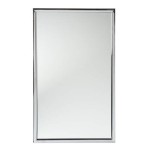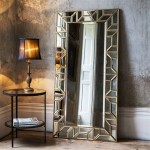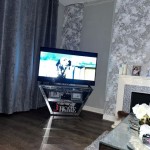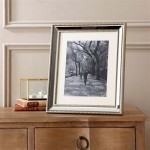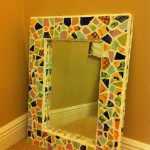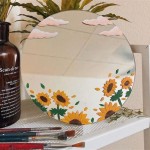What Size Should a Full-Length Mirror Be?
Choosing the right full-length mirror involves considering various factors beyond simply wanting to see one's reflection. The ideal size depends on the user's height, the available space in the room, and the mirror's intended purpose. This article will explore the dimensions to consider when selecting a full-length mirror to ensure it meets specific needs and enhances the overall aesthetic of the space.
The primary function of a full-length mirror is to provide a complete view of the body. Therefore, the height of the mirror is the most critical dimension. A general rule of thumb is that the mirror should be at least half the height of the tallest person who will be using it. This allows for a full view from head to toe, even when standing a short distance away. For most adults, this translates to a minimum height of around 30 inches (76 cm). However, for taller individuals or those who prioritize seeing their entire reflection without having to adjust their position, a mirror of 36 inches (91 cm) or taller is recommended. Mirrors that extend to 48 inches (122 cm) or even 60 inches (152 cm) offer a more expansive view and can be particularly beneficial for checking outfits or practicing posture.
While height is paramount, the width of a full-length mirror also contributes significantly to its functionality. A narrow mirror might suffice for a quick glance, but a wider surface provides a more comprehensive view of the body and clothing. A minimum width of 20 inches (51 cm) is generally considered suitable for individual use. However, for those who wish to see more of their surroundings or who frequently share the mirror with others, a width of 24 inches (61 cm) to 30 inches (76 cm) or more is advisable. Wider mirrors also create a sense of spaciousness in a room, contributing to the overall interior design.
The dimensions of a full-length mirror should also be considered in relation to the available space in the room. A large mirror in a small room can make the space feel cramped and cluttered. Conversely, a small mirror in a large room might appear lost and insignificant. Before purchasing a mirror, one should carefully measure the intended location to ensure the mirror's size is proportionate to the room's dimensions. Consider leaving adequate space around the mirror to allow for comfortable movement and to avoid a sense of overcrowding.
The intended purpose of the full-length mirror further influences the ideal size. A mirror solely for checking one's appearance before leaving the house might not require the same dimensions as a mirror used for dance practice or fitness routines. In the latter cases, a larger mirror, particularly one with greater height and width, offers a clearer and more complete view of body movement and form. This allows for better self-correction and improved technique.
Beyond purely functional considerations, the aesthetic impact of a full-length mirror on the overall interior design of the room merits attention. A well-chosen mirror can serve as a decorative element, enhancing the room's style and visually expanding the space. The frame of the mirror, its shape, and its finish can complement the existing décor, creating a cohesive and visually appealing environment. For example, a large, ornately framed mirror can serve as a focal point in a room, while a sleek, frameless mirror can create a modern and minimalist aesthetic.
Different types of full-length mirrors are available on the market, each with its own set of dimensional considerations. Freestanding mirrors often offer greater flexibility in terms of placement and can be easily moved to different locations. Wall-mounted mirrors, on the other hand, save floor space and can create a seamless, integrated look. Over-the-door mirrors are a practical solution for smaller spaces, maximizing functionality without requiring dedicated wall or floor space. The chosen type of mirror will influence the available size options and should be considered in conjunction with the room's layout and the user's preferences.
In addition to the standard rectangular shape, full-length mirrors are available in various other shapes, such as oval, round, or arched. These alternative shapes can add a unique design element to a room and contribute to the overall aesthetic. When selecting a non-rectangular mirror, it's essential to consider the dimensions of the reflective surface to ensure it provides adequate viewing area for its intended purpose. The overall dimensions of the mirror, including the frame or surrounding structure, should be carefully measured to ensure it fits comfortably within the allocated space.
Ultimately, the perfect size for a full-length mirror is a subjective decision based on individual needs and preferences. Careful consideration of height, width, available space, intended purpose, and aesthetic impact will ensure a well-informed choice that enhances both functionality and style.

How To Choose The Size Of Full Length Mirror

Neutype 51 X16 Rectangular Full Length Floor Mirror With Stand Gold Com

51 Full Length Mirrors To Flatter Your Decor And Outfits

Fm03 Full Length Mirror Black Chrome Frame Wall Mountable Standable Emke Emkedirect Co

Large Standing Full Length Mirror Wall Decor For Hanging China Decorative Mounted Made In Com

Xramfy 24 In W X 71 H Rectangular Modern Black Aluminum Framed Rounded Full Length Mirror Fmcarc2471 Bk The Home Depot

Why You Should Have A Full Length Mirror In Your Home

Biyatuos 63 X20 White Rectangle Full Length Floor Mirror Dimming Lights Bedroom Tall Size Free Standing Wall Mounted Hanging Touch Control Com

Best Choice S 65x22in Full Length Mirror Rectangular Beveled Wall Hanging Leaning Floor Target

Polished Aluminium Frame Full Length Glass Mirror For Home Size 4x1 5 Feet At Rs 5100 In Mumbai

